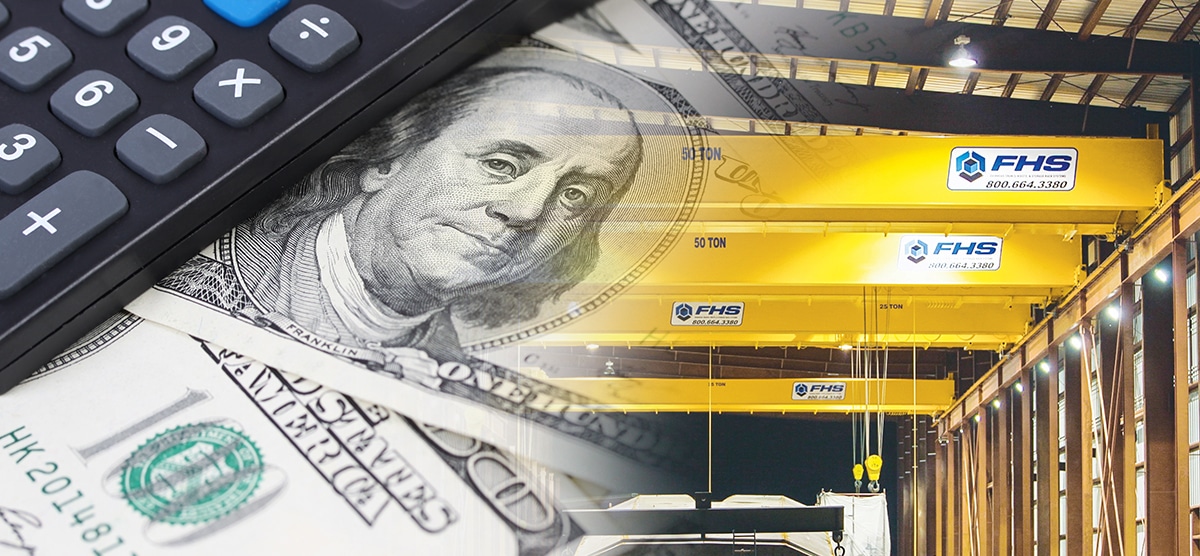Cost of a New Overhead Crane
<p>If you’re just starting your research, we understand that the process of buying and installing an overhead crane in your facility can seem somewhat overwhelming. You may be moving into a new building, replacing an old or outdated piece of equipment, or may be buying an overhead crane for the first time and are looking to expand your business’ material handling capabilities. In this section, we’ll discuss the factors that affect the cost of any type of crane.</p>
If you’re just starting your research, we understand that the process of buying and installing an overhead crane in your facility can seem somewhat overwhelming. You may be moving into a new building, replacing an old or outdated piece of equipment, or may be buying an overhead crane for the first time and are looking to expand your business’ material handling capabilities. In this section, we’ll discuss the factors that affect the cost of any type of crane.

What Affects the Price of an Overhead Crane?
To make sure that you get the right type of overhead crane for your business, you should be ready to address the following information when you contact an overhead crane manufacturer to bid on your project:
- The type of crane you need
- The span you need to cover under the crane, or horizontal distance center-to-center of the runway rails
- The capacity, or maximum rated load, that you need your crane to lift
- The estimated height of your crane, or required lift
- How fast the crane will need to be
- How often you will use your crane
- The environment that your crane will be operating in
- If you need a runway, the length of your bay that the crane will need to traverse
- Any special building or structural requirements for operation or installation

What Type of Overhead Crane Do You Need?
An overhead crane is a complex piece of equipment, and there are many different types of overhead cranes to choose from. The complexity of the overhead crane components required to operate the crane, the engineering required to design the crane, and the application (industry or materials being lifted) will determine what type of crane you will need.
For example, an 80 foot, 20-ton double girder bridge crane will cost significantly more than a 40 foot, 10-ton double girder bridge crane.

What is the Span of the Overhead Crane?
The span, or distance between the runway rails, is one of the biggest contributing factors to the cost of an overhead crane. The longer the crane’s span, the more material is required to build the crane girders. This added material increases the crane’s weight, which will also increase the cost of the runway, if required.

What is the Capacity or Maximum Rated Load?
An overhead crane’s capacity is the maximum load which may be applied to the crane in a particular working configuration, and under a particular condition of use.
When the manufacturer comes on-site to provide a consultation, they can calculate the capacity based on their understanding of:
- The size and weight of the material that you’ll be lifting
- Below-the-hook lifting devices that may need to be used
- Single hoist or double hoist configuration
- Any other considerations for future crane usage or capabilities
A crane that requires a large capacity, a large span, or severe service classification, may require a double girder design—meaning there are two beams that make up the bridge. These girders can be designed in a rigid welded steel box girder design for added reinforcement. This type of setup will be the most expensive, as there are significant increases in labor and material charges to weld and fabricate the girders.

What is the Duty Cycle or Service Classification?
There are six different classifications of overhead cranes, specified by the Crane Manufacturers Association of America (CMAA).
An overhead crane manufacturer will determine what type of crane classification they’ll need to build for your specific lifting application, using the following criteria:
- How frequently will the crane be used?
- How quickly will the crane need to transfer equipment or materials?
- How many lifts per hour will the crane need to perform?
- Will the crane be needed for regular or frequent service?
- How far does the crane need to move material in your facility?
- What is the average rated load of the materials that will be moving?
- How often will the crane be making lifts at full capacity?
- In what type of environment will the crane be operating?
Class A and Class B cranes will be your least expensive option because they’ll be used mostly for maintenance or the initial installation of equipment. They’re used infrequently, and there are long periods of idle time between lifts.
Class C cranes will be a middle-of-the-road type crane. There may be some additional engineering built-in to the project for a specific need, but they typically utilize a basic hoist, trolley, and bridge design. They’re used moderately to handle loads at or around 50% capacity and are in service for about 5 to 10 lifts per hour.
Class D and Class E cranes, often referred to as process cranes, are built for a specific need and are more heavy-duty. They may be constantly running in excess of 50% of the rated capacity, and they’re making 15 or more lifts per hour. They have more engineering or customized solutions built into the design for the specific lifting application—which increases initial design and engineering costs for the project.
Class F cranes must be capable of handling loads approaching rated capacity continuously, under severe service conditions, throughout their lifetime. They’ll be extremely expensive due to additional costs related to design and engineering, sourcing of heavy-duty components, materials and labor, and installation.

What is the Operating Environment?
A severe, obstructed, or dangerous operating environment where the crane will be installed and running, will affect the cost of an overhead crane in several different ways.
Environmental factors such as high heat, the presence of chemicals or fumes, steam, dust, or excess moisture can require special metal coatings to protect and enhance the operating life of the crane. The individual components of the crane will also need to be sourced to ensure that they can hold up and withstand the operating environment.
Facilities like wastewater treatment plants, fertilizer plants, and oil and gas processing facilities require explosion proof cranes. This means that the equipment cannot generate any type of spark. These types of cranes can utilize a specific pneumatic air-powered system, or a specially-designed electrical system to make them explosion proof—however, these can be expensive to design and install.
Cranes that will be used outdoors will need additional protective coatings to prevent corrosion and will require weatherproofing to seal out moisture and dust or dirt. Stainless steel or galvanized components will also need to be sourced to ensure that they can handle exposure to the elements and don’t rust.
A dangerous operating environment will also require special equipment and protection (PPE) for the installers during installation. Any obstructions to the installation area can add to the cost if the installers don’t have clear access to the area to remove an existing structure or install a new one.

What is the Length of the Runway?
The runway length is the largest contributor to the runway cost itself. This length can also play into the cost of the crane. If you need to make multiple picks per hour and have a long runway, then you may need a faster trolley and hoist to move up and down the runway quickly. The additional speed may require the components of the crane to be sized to a higher capacity.
A faster crane that travels the length of the building may also require the operator to work from within an exposed or enclosed cab—which is more expensive than radio or pendant controls.

What are the Building or Structural Requirements for Operation or Installation?
If an overhead crane is being installed in a new construction facility, then typically the runway beams will be installed during the construction process, and the crane manufacturer won’t need to include the runway structure in the quotation process. Care must be taken with your construction contractor, as crane runway tolerances are much tighter than standard construction codes. Repairing a runway that is out of tolerance can add significant cost to the installation.
If a crane is being retrofit into an existing building, there will be added costs for the design, fabrication, delivery, and installation of the crane’s runway system.
Most crane manufacturers don’t offer in-house structural repair or certification services, so you’ll also have to consider any additional costs related to having concrete contractors or structural engineers provide a consultation of your facility. They’ll need to determine if the existing building structure and foundation can handle the additional loads generated by the installation of an overhead crane system.
Quoting an Overhead Crane System
Once you’ve gone through the consultation process, a group of estimators, engineers, draftsmen, and project managers all get together and begin putting together a comprehensive proposal.
As you can see, there are so many different factors that can affect the price that you’ll pay for an overhead crane system. The two most important aspects are span and capacity. These will determine how much labor and material will be required for the project, and will also dictate the complexity and design of the hoist, trolley, bridge, controls, and power system—all major players in how much a crane will cost you.
The quotation process can take anywhere from 3-30 business days depending on the number of cranes being quoted, the complexity of the project, and the sourcing of crane components. Once they’ve completed this process, they’ll get back in touch with you to submit their official bid for the project.
Remember, the more information you can provide to a crane manufacturer during the consultation / quotation process, the better they’ll be able to provide an accurate quote for you to review.
